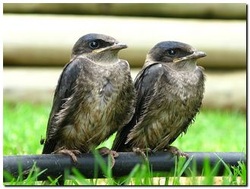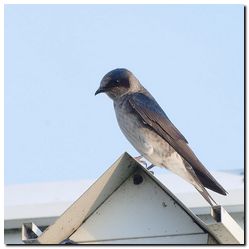About Purple Martins

The Purple Martin (Progne subis) is the largest North American swallow. These aerial acrobats have speed and agility in flight, and when approaching their housing, will dive from the sky at great speeds with their wings tucked.
Description and taxonomy
Purple Martins are a kind of swallow, of the genus Progne. Like other members of this genus, they are larger than most of the other swallows. The average length from bill to tail is 20 cm (7.9 in). Adults have a slightly forked tail. Adult males are entirely black with glossy steel blue sheen, the only swallow in North America with such coloration. Adult females are dark on top with some steel blue sheen, and lighter underparts. Subadult females look similar to adult females minus the steel blue sheen and browner on the back. Subadult males look very much like females, but solid black feathers emerge on their chest in a blotchy, random pattern as they molt to their adult plumage.
Description and taxonomy
Purple Martins are a kind of swallow, of the genus Progne. Like other members of this genus, they are larger than most of the other swallows. The average length from bill to tail is 20 cm (7.9 in). Adults have a slightly forked tail. Adult males are entirely black with glossy steel blue sheen, the only swallow in North America with such coloration. Adult females are dark on top with some steel blue sheen, and lighter underparts. Subadult females look similar to adult females minus the steel blue sheen and browner on the back. Subadult males look very much like females, but solid black feathers emerge on their chest in a blotchy, random pattern as they molt to their adult plumage.
Distribution and habitat
Purple martins' breeding range is throughout temperate North America. Their breeding habitat is open areas across eastern North America, and also some locations on the west coast from British Columbia to Mexico. Martins make their nests in cavities, either natural or artificial. In many places, humans put up real or artificial hollow gourds, or houses for martins, especially in the east, where Purple Martins are almost entirely dependent on such structures. As a result, this subspecies typically breeds in colonies located in proximity to people, even within cities and towns. This makes their distribution patchy, as they are usually absent from areas where no nest sites are provided. Western birds often make use of natural cavities such as old woodpecker holes in trees or saguaro cacti. The Purple Martin migrates to the Amazon basin in winter. Its winter range extends into Ecuador but does not seem to ascend far up the Andean foothills. The first record of this species in Europe was a single bird on Lewis, Scotland on 5–6 September 2004, and the second was on the Azores on 6 September 2004.
Purple martins' breeding range is throughout temperate North America. Their breeding habitat is open areas across eastern North America, and also some locations on the west coast from British Columbia to Mexico. Martins make their nests in cavities, either natural or artificial. In many places, humans put up real or artificial hollow gourds, or houses for martins, especially in the east, where Purple Martins are almost entirely dependent on such structures. As a result, this subspecies typically breeds in colonies located in proximity to people, even within cities and towns. This makes their distribution patchy, as they are usually absent from areas where no nest sites are provided. Western birds often make use of natural cavities such as old woodpecker holes in trees or saguaro cacti. The Purple Martin migrates to the Amazon basin in winter. Its winter range extends into Ecuador but does not seem to ascend far up the Andean foothills. The first record of this species in Europe was a single bird on Lewis, Scotland on 5–6 September 2004, and the second was on the Azores on 6 September 2004.

Relationship with humans
The population of eastern Purple Martins (nominate form P. s. subis) is dependent on artificial martin houses of wood or aluminum and fake plastic gourds, supplied by individuals and organizations fond of the bird. This tradition was in place even before the population crash; Native Americans are said to have hollowed out gourds and erected them for this purpose. The situation requires ongoing maintenance, as European Starlings and House Sparrows compete with martins as cavity-nesters, and will fight with martins over nest sites. Starlings have even been known to kill Purple Martins, especially nestling young, and Purple Martins have been known to evict House Sparrows from their nests. Thus, unmonitored Purple Martin houses are often overtaken by more aggressive, non-native species. Purple Martin proponents are motivated by the concern that the Purple Martin would likely vanish from eastern North America were it not for this assistance
The population of eastern Purple Martins (nominate form P. s. subis) is dependent on artificial martin houses of wood or aluminum and fake plastic gourds, supplied by individuals and organizations fond of the bird. This tradition was in place even before the population crash; Native Americans are said to have hollowed out gourds and erected them for this purpose. The situation requires ongoing maintenance, as European Starlings and House Sparrows compete with martins as cavity-nesters, and will fight with martins over nest sites. Starlings have even been known to kill Purple Martins, especially nestling young, and Purple Martins have been known to evict House Sparrows from their nests. Thus, unmonitored Purple Martin houses are often overtaken by more aggressive, non-native species. Purple Martin proponents are motivated by the concern that the Purple Martin would likely vanish from eastern North America were it not for this assistance

Migration
Wintering in South America, purple martins migrate to North America in spring to breed. Spring migration is somewhat staggered, with arrivals in southern areas such as Florida and Texas in January, but showing up in the northern United States in April and in Canada as late as May. Males usually arrive at a site before females.Fall migration is also staggered, as birds head south when the breeding season is over. Some birds leave as early as July and others stay as late as October. Martins generally migrate over land, through Mexico and Central America. When not breeding, martins form large flocks and roost together in great numbers. This behavior begins just prior to the southern migration and continues on the wintering grounds.
Wintering in South America, purple martins migrate to North America in spring to breed. Spring migration is somewhat staggered, with arrivals in southern areas such as Florida and Texas in January, but showing up in the northern United States in April and in Canada as late as May. Males usually arrive at a site before females.Fall migration is also staggered, as birds head south when the breeding season is over. Some birds leave as early as July and others stay as late as October. Martins generally migrate over land, through Mexico and Central America. When not breeding, martins form large flocks and roost together in great numbers. This behavior begins just prior to the southern migration and continues on the wintering grounds.

Breeding
Eggs and small chicks in a nest box in Oklahoma, USA. Males arrive in breeding sites before females, and establish their territory. A territory can consist of several potential nest sites. After forming a pair, both the male and female inspect available nest sites. This process is complicated by the fact that artificial nest sites could be houses with many rooms, clustered gourds, or single gourds. The nest is made inside the cavity of such artificial structures and retains a somewhat flat appearance. The nest is a structure of primarily three levels: the first level acts as a foundation and is usually made up of twigs, mud, small pebbles and in at least a few reported cases, small river mollusk shells were used; the second level of the nest is made up of grasses,finer smaller twigs; the third level of construction composing the nest, is a small compression usually lined with fresh green leaves where the eggs are laid. Three to six eggs are laid, and the female is the main incubator, with some help from the male. Purple Martins are generally known to raise only a single brood. Fledgling, when the young leave the nest, occurs at about one month, after which the parent continue to feed the fledgling young.
Eggs and small chicks in a nest box in Oklahoma, USA. Males arrive in breeding sites before females, and establish their territory. A territory can consist of several potential nest sites. After forming a pair, both the male and female inspect available nest sites. This process is complicated by the fact that artificial nest sites could be houses with many rooms, clustered gourds, or single gourds. The nest is made inside the cavity of such artificial structures and retains a somewhat flat appearance. The nest is a structure of primarily three levels: the first level acts as a foundation and is usually made up of twigs, mud, small pebbles and in at least a few reported cases, small river mollusk shells were used; the second level of the nest is made up of grasses,finer smaller twigs; the third level of construction composing the nest, is a small compression usually lined with fresh green leaves where the eggs are laid. Three to six eggs are laid, and the female is the main incubator, with some help from the male. Purple Martins are generally known to raise only a single brood. Fledgling, when the young leave the nest, occurs at about one month, after which the parent continue to feed the fledgling young.
Diet
Purple Martins are aerial insectivores, meaning that they catch insects from the air. The birds are agile hunters and eat a variety of winged insects. Rarely, they will come to the ground to eat insects. They usually fly relatively high, so, contrary to popular opinion, mosquitoes do not form a large part of their diet.
Purple Martins are aerial insectivores, meaning that they catch insects from the air. The birds are agile hunters and eat a variety of winged insects. Rarely, they will come to the ground to eat insects. They usually fly relatively high, so, contrary to popular opinion, mosquitoes do not form a large part of their diet.
Vocalization
Purple Martins are fairly noisy, chirping and making sounds that have been described as chortles, rattles, and croaks. The various calls are said to be "throaty and rich" and can be rendered as tchew-wew, pew pew, choo, cher, zweet and zwrack. The males have a gurgling and guttural courtship song, a dawn song, and even a subsong used at the end of the breeding season. Tapes of Purple Martin song are sold to attract martins to newly established birdhouses.
Purple Martins are fairly noisy, chirping and making sounds that have been described as chortles, rattles, and croaks. The various calls are said to be "throaty and rich" and can be rendered as tchew-wew, pew pew, choo, cher, zweet and zwrack. The males have a gurgling and guttural courtship song, a dawn song, and even a subsong used at the end of the breeding season. Tapes of Purple Martin song are sold to attract martins to newly established birdhouses.

